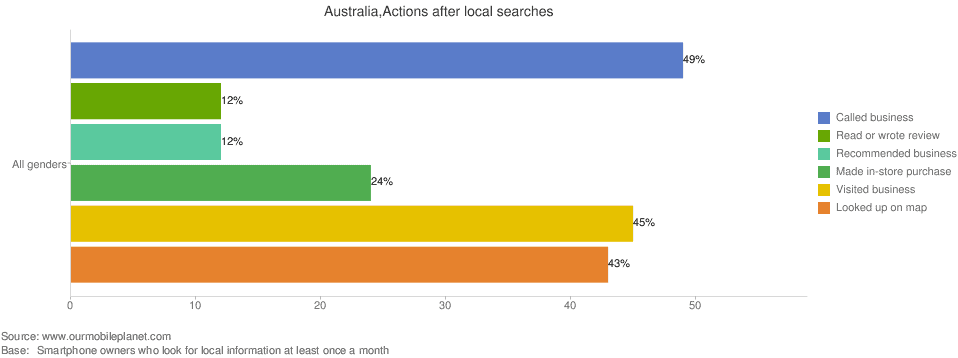Digital Marketing – 2011 The Year in Review
This time of year is great for looking back at the past twelve months. Not just with nostalgia, but with an eye towards learning what influenced our industry, our activities, and even your business! We’ll be following up this with a series of posts in 2012 on how to harness online marketing trends to grow…

This time of year is great for looking back at the past twelve months. Not just with nostalgia, but with an eye towards learning what influenced our industry, our activities, and even your business!
We’ll be following up this with a series of posts in 2012 on how to harness online marketing trends to grow your business.
We started the year thinking about Online Marketing Trends for 2011, and in this review, we’ll just touch on the 5 big movers that we think will influence your business – some of these were there in 2011, and of course, some are new!
1. Mobile Internet Usage
Mobile internet usage is up 50% according to the Australian Bureau of Statistics, while overall internet access grew 17% in the same period. Mobile internet access is counted as mobile broadband, mobile phones, and tablet computers such as iPads.
Australia has gone from lagging in smartphone and mobile internet use, to being a global leader with the second highest penetration of smartphone usage, according to Google. The number of people accessing the internet on their phone went past 50% in 2011, and with the refresh rates for mobile driving adoption of smartphones – the number of people with internet on their phone is expected to top 70% in 2012.
The interesting part of this is how active these users are on their mobile internet – 40% use search daily, and then call the business, read reviews and look them up on maps. This data and other interesting graphs from www.ourmobileplanet.com.
Clearly, if your website is not mobile compatible, then you are going to be missed! Check out point number five if a mobile website is on the top of your list for 2012.
2. Social Media for Business
Looking back on it now, 2010 was all about the buzz of engaging in Social Media (Facebook, Twitter, LinkedIn being the big three). And in 2011, most of the companies we worked with and talked to took a much harder look at Social Media use, with a real focus on measuring the benefit and return on investment.
This included active monitoring of website traffic sources. Applications in Facebook to get people to sign-up for newsletters, or submit enquiry forms within Facebook topped the interest tables.
Recent stats show Facebook users topped 10 million in Australia in 2011. Facebook remains a powerful tool for B2C brands, but just as companies are looking for the return on investment – individuals on Facebook are also increasingly looking at what’s in it for them. In November Facebook upgraded Insights, their analytic tools, to provide brands with better measurement on the reach and engagement for posts and content.
The real question for 2012 is how can you put your business and brand out in social media, in a genuine, authentic, real way? If you can do that, you are more likely to create a real connection with your customers in social media, and therefore make a real impact on your business.
3. Online Reviews and Virtual Word of Mouth
In March, Nielsen Research released The State of The Online Nation. This confirmed our belief that customers are increasingly engaged with brands, especially reading and adding to online reviews. Nielsen found that 73% had read reviews, and 26% do so on a regular basis. On a more active level, 46% have commented, and 33% post new reviews. This will only accelerate with the arrival of Yelp Australia – the popular US site that pulls over 20 million visitors a month and has reviews for every kind of business – from hairdressers to haberdashers.
This is a critical part of being engaged with your customers. You can manage your listing in Yelp, respond to reviews, and be an active participant. You can do the same in other review sites, directories and social media. Extending customer service into these areas provides a tremendous benefit to the companies we have worked with, so I’m sure it will for yours as well.
4. WordPress for Websites
The popularity of WordPress continues to grow. Stats released this year by WordPress.org found that 22% of all new websites in the USA in 2011 were built using WordPress.
As far as a content management system goes – WordPress has a 55% market share. These numbers are back-up by Google Insights – showing the steady rise of searches for “wordpress website”.
WordPress continued to develop in 2011, with Version 3 released, and a raft of new features. And of course, lots of new plugins including a few released by us here at TheDMA.
The sophistication of WordPress continues to grow, and it used by a large number of complex and high profile sites – including the UK Prime Minister’s site #10 Downing Street.
5. Responsive Web Design
The term “responsive design” was coined by Ethan Marcote in 2010, where he argued that we web designers need a better way to present content on the variety of canvases we design for – including mobile phones, tablets, netbooks, large screens.
These can range from 1600 pixels wide, down to 320 on a smartphone. As we discussed earlier, the large number of people going online on mobile devices is accelerating these requirements, and Responsive Design is the most elegant and powerful way to meet these requirements.
Responsive Design creates a website that will automatically detect the size of the device, and re-scale, re-stack, and re-present that content to appear on the smaller canvas while still maintaining the design elements. Retaining the design and images also retains the branding and presentation of the site, and makes for a powerful and engaging site – from the desktop to the tablet to the smartphone.
At TheDMA we are starting to do custom sites with responsive themes, and in 2012, we will have a number of Premium Templates which are also responsive. Two interesting examples of responsive design are Food Sense and The Boston Globe. When you open these on your desktop, grab the lower left corner of your browser and start pushing them smaller, more narrow, and see how Responsive Design works.
6. And Then…
And then … there were 6 in my list of Top 5 Trends. Well you might call this 6+.
“+” as in Google+ arrives, and provides another social networking site, a way to recommend search results and web pages (you can + this page). This is a long term trend, as Google and Facebook look to add a social layer to the web, with the theory that this will increase the relevance and usefulness of links, searches, and of course, advertising. Very much in its infancy, but worth watching none the less over the coming years.
2011 will also be remembered as the year that Australian Retailers woke up to the reality of e-commerce. Australia lags the US and Europe in e-retailing as a percentage of overall consumer spending, so we expect e-retailing to accelerate in the coming years, as consumers embrace greater choice and lower costs.
Yellow Pages stopped printing, and went wholly online. Not happy Jan? Will this make you re-think your marketing ? It does mark the end of set-and-forget marketing, and may require some extra effort. But in return you will learn a lot more about your customers, and where they come from – what you do with that information is up to you.
2012
We’re not overly nostalgic here at TheDMA. We like to look back at stats, results, trends – learn what we can, and apply that to the future. If you are ready for some future thinking and present actions in your online marketing stay tuned to this blog as we bring you monthly online marketing up-dates in 2012, or get in touch and let’s talk about how we can help you achieve your goals in 2012.



Reader Interactions